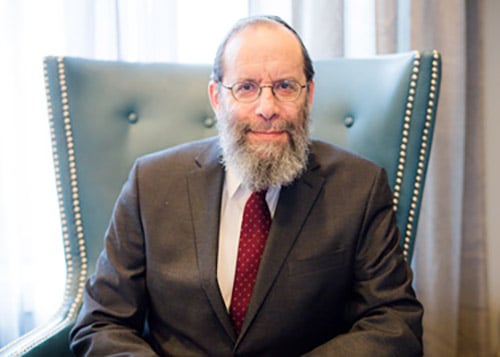Educated in Frankfurt am Main and in the great yeshivas of Lithuania, Rav Shimon Schwab was a talmid chacham and traditionalist interpreter of the path of “Torah im Derech Eretz”—balancing strict observance with a conservative participation in Western society. Rav Schwab composed “Ma’ayan Beis haShoeva” and numerous other classic Torah works, and for many years led Kehal Adas Yeshurun in Washington Heights, Manhattan.
In the spring of 1930—as a 20-year-old yeshivah student—Rav Schwab had the privilege of spending a weekend with Reb Yisrael Meir Kagan, the great Chafetz Chaim. This experience made a strong impression on the young ben Torah. Rav Schwab would often refer to the encounter as a watershed moment in his life, and continued to draw insight and inspiration from it throughout his life.
During their initial meeting on Erev Shabbos, following cursory inquiries as to his background and family, the Chafetz Chaim surprisingly asked Rav Schwab if he was a Kohen. “No,” was his reply. “Are you a Levi perchance?” Once again, the young bachur replied in the negative.
“Aha,” said the Chafetz Chayim, “perhaps you have heard, I am actually a Kohen. Soon, Mashiach will arrive and the Beis Hamikdash will be rebuilt. All we have yearned for over 2,000 years will be realized. The Kohanim and Leviim, will be privileged to fulfill our respective duties. You, young man, however, will not have the zechus of performing the avodah, and will have a different role altogether. Tell me, young man, why—in fact—are you not a Kohen?”
“I am not a Kohen because my father is not a Kohen,” answered Rav Schwab, now confused. The Chafetz Chayim continued to press him: “And tell me, your father, why is he not a Kohen?”
By now, Rav Schwab understood that the gadol hador was driving at something, so he remained silent and waited for the lesson that was unfolding. The Chofetz Chaim’s kind and gentle eyes were filled with a fire of intensity …
“Allow me to explain… About 3,000 years ago, all of us stood together at Matan Torah and experienced the peak of human history. The Ribbono Shel Olam gifted us the Torah, the greatest expression of His love and trust in us. And then … ” He paused and cleared his throat. “ … And then we fell to the lowest places at the Cheit HaEgel. At that moment, Moshe Rabbeinu descended from Har Sinai and, shocked at the sight of Jews dancing around the golden calf, abruptly shattered the luchos. מי לה׳ אלי—He cried, ‘Whoever is for Hashem, join me!’”
“You see, that’s when my Zeidy’s Zeidy—a member of Shevet Levi—answered the call and stood up against the idolatrous celebration, while your family did not!”
“My dear young man, listen carefully. In the course of your life, there will be times when you will be faced with the opportunity to heed Moshe’s cry of מי לה׳ אלי—‘Whoever is for Hashem, join me!’ Make sure to listen to him and act accordingly; actions have repercussions for many generations!”
~
וַיַּרְא משֶׁה אֶת־הָעָם כִּי פָרֻעַ הוּא …
וַיַּעֲמֹד משֶׁה בְּשַׁעַר הַמַּחֲנֶה וַיֹּאמֶר מִי לַה׳ אֵלָי וַיֵּאָסְפוּ אֵלָיו כָּל־בְּנֵי לֵוִי:
“Moses saw that the people were out of control … And Moses stood up in the gate of the camp and said, ‘Whoever is for Hashem join me!’ And all the men of Levi rallied to him,” (Shemos, 32:25-26).
The tragic degradation and traumatic experience of the Cheit HaEgel sadly remains imprinted on the collective consciousness of klal Yisrael. The callous rebelliousness and reprehensible behavior we exhibited in the shadow of the awesome revelation at Har Sinai is a painful memory and a stain that we have still not completely reconciled.
Reb Shraga Feivel of Gritza—the first of the Alexander Rebbes—visited the Chozeh of Lublin. The Chozeh asked, “Feiveleh, do you know what was the deepest tragedy of the Egel HaZahav?” Reb Shraga Feivel answered what he thought to be obvious: “Klal Yisrael made a graven image, bowed to it and were guilty of avodah zara.”
“You are mistaken,” said the Lubliner. “That was certainly a grievous error. But what exacerbated the cheit—making it such a tragedy—was that a little later (Shemos, 33:4), ויתאבלו—‘they mourned.’”
Instead of immediately acting on the recognition of their wrongdoing, Bnei Yisrael were consumed with regret and were broken by their mistake. When Moshe Rabbeinu called them to immediately turn back to Hashem, there was an opportunity for immediate rectification. Not only did most of the nation hesitate, they fell further and plummeted into a dark depression. Even after the Leviim had slayed the instigators, and Moshe had ascended the mountain to ask for the people’s forgiveness, and a plague struck those who had taken part in the sin but were not warned against it—the people still “mourned” the aveira. They had repeatedly missed those opportunities to apply themselves in teshuva and “join” Moshe.
Even today, the cry of מי לה׳ אלי continues to reverberate in different ways. We are called to awaken and recognize our errors—and to summon the faith to change our trajectory as quickly as possible. Wallowing in grief may seem appropriate, but it is really an egoistic reaction which only drags us down further. Our tikkun is only “complete” when we lovingly accept “Moshe’s rebuke,” and return—with joy—to our derech.
As we revisit the embarrassing episode of the golden calf once again, let us internalize the Chofetz Chaim’s message: “No matter our mistakes, may we get up right away and stand with Moshe, with our sages, our rebbes and wise friends. May we let go of guilt and grief as soon as they have done their job, return to serving Hashem besimcha, and go up all together to our ‘land flowing with milk and honey,’” (33:3) …
ופדויי ה׳ ישובון ובאו ציון ברינה …
“And Hashem’s ransomed shall return,
And come with shouting to Zion,
Crowned with everlasting joy.
They shall attain joy and gladness,
While sorrow and sighing flee.”
(Yeshayahu, 35:10)
Rav Judah Mischel is executive director of Camp HASC, the Hebrew Academy for Special Children. He is the mashpiah of OU-NCSY, founder of Tzama Nafshi and the author of “Baderech: Along the Path of Teshuva.” Rav Judah lives in Ramat Beit Shemesh with his wife Ora and their family.











